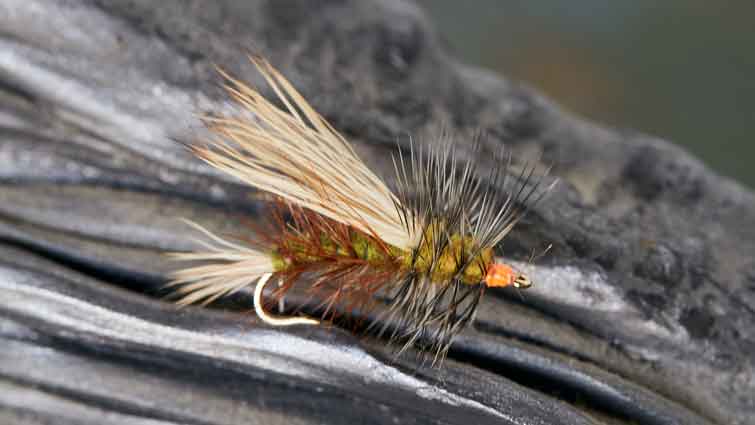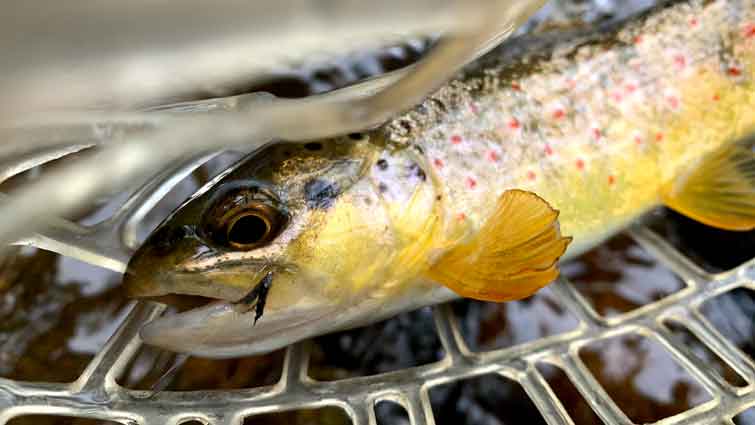Oftentimes it's the sight of a fly struggling in the surface film that triggers an instinctive reaction. Whether you've recently switched to dry-fly fishing or you're just beginning, know that there are important rules for playing and landing your fish. Treating your dry flies so they float more effectively is one of them.

As a general rule treating your dry flies refers to applying a floatant. There are numerous types of Floatant on the market. Liquids, powders, shakes, etc. Assisting your dry flies in floating efficiently is an art in itself. You can apply floatant by coating dry flies with liquid versions. Powder and gel floatants can also be applied by shaking or dropping directly onto the fly.
It isn't always necessary to apply Floatant depending on what type of conditions or waters you are fishing. For instance, rivers that are flowing incredibly quickly may not need any Floatant at all. This article will discuss float ants that you add to a dry fly to make it float better. There are numerous types of Floatant on the market. Liquids, powders, shakes etc.

Treating Dry Flies
Treating dry flies is a great way to give them an extra umph so they float for longer and rise better. If you're a fly fisherman, there are a few different ways you can treat your dry flies.
First of all, you can coat the fly with floatant that is used for keeping dry flies afloat. This will keep your fly floating on top of the water much longer.

When you land your fly on the water, if it splashes down and immediately sinks, then go ahead and add floatant; but if it floats along flat until it gradually settles in the current, then leave it alone.
If you're fly fishing with a dry fly, you'll need some sort of floatant. If the dry fly becomes saturated and sinks, it's basically worthless. The best option is to pretreat your flies with one of these products beforehand.
What is Floatant?
Floatant is an coating that is applied directly onto the fly. Floatant creates a barrier of water-repelling gel around the fly. It should only be applied when the fly is dry. It is crucial to make sure you put on the floatant before any water touches the fly. This coating will help the fly to float.

It isn't always necessary to apply Floatant depending on what type of conditions or waters one will be fishing. For instance, rivers that are flowing incredibly quickly may not need any Floatant at all. For most cases, though, a little of a few types will help out.
Listed below will be a few tips and tricks for applying floatant to dry flies:
- Shake the bottle of Floatant before using it (the ingredients want to settle)
- Make sure that your hands are not wet when handling the Floatant.
- Allow floatant a few minutes to dry.
If you add too much Floatant or apply it directly onto the fly, then use a dry cloth or tissue to wipe off any excess. The fly should still be able to move freely in the water with ease.
Types of Floatants
There are multiple types of floatant. Powder, Cream, or liquid are most common. Also, some work better on some materials than others do. There are different types of floatant available for fly fishing.

You can also find reliable floatants that work on all types of fly lines at fishing supply stores. When it comes to dry fly fishing, Floatant is your best friend, and after you've tied one to your line, applying it should be the first thing you do. Floatant works to convince fish that its prey is still alive, because the live insects are either not drowned or continue to breathe underwater due to water-resistant coating.
Floatants come in several forms: sprays, liquids, pastes and powders. Floatants mimic natural oil secreted by aquatic insects to repel water after they have emerged from freshwater. Fish often mistake these oils for natural food sources found under water, making floatants useful tools when fishing dry flies. Floatants work depending on your fly line type when you want it to help float your artificial insect pattern through the water column.

Powder Floatant
The powder is usually used with deer hair. This is the easiest type of floatant to apply because it comes in a shaker container and can be applied directly to the fly without ever touching it with your fingers. It typically only requires about three shakes over the fly before wetting it to activate its effectiveness.
Most powders float for hours, even with constant submersion. If you have problems with powder getting into your fishing line, try using tippet rings made from tippet material instead of yarn loops at the end of your leader as an alternative option

Liquid Floatant
These are by far the easiest to use when treating dry flies because you simply add drops from a dropper bottle. However, they do have their limitations. For one thing, liquids generally contain soapy ingredients, which may actually attract fish during low-light conditions and attract dirt and debris in high-light conditions.
This matting effect on your flies could reduce their buoyancy and cause tangling problems when fishing with wet flies or nymphs that sink very deep and fast. Also, liquids float for a short period of time and don't usually stay on the fly as long as powders do. Some liquid Floatants can be corrosive to certain types of metal hardware such as zippers, buckles, swivels, and snaps.
Gink is a light paste that becomes a liquid at body temperature. It transforms back to its clear, undetectable gel form when exposed to cold water, preventing your dry flies or streaking streamers from becoming wet. Rinse the fly after you've caught a fish and false cast dry it.
Cream Floatant
Cream Floatant is very similar to the powder in that it comes in a shaker container but is much denser than the powder due to its thicker paste-like consistency. The Cream has basically the same properties as the powder; however, they are less likely to clog your tippet rings and tend not to sink so quickly. They also don't leave any visible residue or film on your fly like the liquids.

Other Floatant
There are also floatants that are compatible with synthetic materials such as nylon, polyester, rayon, and so on. These types of Floatant tend to leave more of a visible light residue on your fly than the others. Many still think that this residue or "gloss" actually helps in attracting fish during low-light conditions.
Some even say it makes the fly pathetically easy to spot when fishing clear water. Try using these types of floats on larger dries as Stimulators flies.
How to Apply Floatant to Dry Flies
Applying floatant to dry flies can be done through various methods. The most common way is to shake some on top of the fly. Another method is to lightly coat the dry fly with your fingers before it meets the water. This will allow for more Floatant uptake but is also more likely to damage delicate materials like deer hair.
Shaking
The most popular method of applying Floatant is to just shake it over the fly. It's simple, and it works. When using powder, this is all you need to do. However, with liquids, many anglers like to add a few drops directly onto the fly or inside of their cap before putting it on the dropper.
Most prefer not to do this because it wastes more Floatant than necessary if you accidentally spill some in the process. Instead, when fishing topwater dry flies or hair-wings, simply put one drop on your finger and use that same finger to dab some on the wings of the fly.
Painting or Dropping
Some anglers prefer not to shake the container over their dry flies at all. Instead, they just scrunch up a paper towel or tissue and "paint" it on. This is also an acceptable method so long as you rub the paste-like substance evenly onto your fly until it's covered.
Don't try putting too much Floatant onto one spot because it will actually repel water and cause the fly to float even higher off the bottom than normal. This can be problematic when fishing with nymphs that sink very fast. Apply only enough product to make the material slightly moist, not saturated.

How Do You Keep Dry Flies Floating?
A dry fly sinks when it is saturated with water. To keep it floating, you need to dry it out with a desiccant and apply a floatant gel, such as Gink. It is best to apply floatant to a completely dry fly. For the stubborn fly that refuses to float, changing out flies might be the best solution.
Using floatant on dry flies is the best way to help them float better. There are many different brands on the market, each with its own pros and cons. Some are designed for specific kinds of dry fly materials, while others can be used universally.
How Do You Dress Dry Flies?
Floatant comes in many different forms: powder, liquid, cream, paste, etc. When using a liquid Floatant, you can either choose to dip your entire fly into the solution, or you can apply it sparingly. This is done by just putting one drop on your little finger and then dabbing it onto the wings of the fly, after which you should let them dry naturally.
Watershed and Hyrdostop are two of the most popular and effective dry fly treatments, which are also known as permanent floatants. These concoctions aren’t perfect, but if you struggle with keeping your dry flies from sinking or get tired of reapplying floatant all the time, using fly treatments might be worth a try.
How Do You GINK a Fly?
When using liquid Floatant, you can just shake it over the fly. It's simple, and it works. When using powder, however, many anglers like to add a few drops directly onto the fly or inside of their cap before putting it on the dropper.
Gink has a specific gravity of 0.77%, which means it's lighter than water. It's a liquid emulsifier that penetrates deep into the body of dry flies. To use Gink on your dry flies, whilst holding your dry fly, apply Gink directly to your dry fly and rub gently across the pattern until it's completely wet. Then run the excess Gink up the leader for additional float.
"Ginking" is just another word for anointing your flies with floatant. This allows them to rest at their natural level in the water and not be caught up in currents or obstacles, which can cause drag and broken leaders etc.

You don't need much floatant at all when using Gink because it penetrates deep into the body of your fly. Only add enough product so that when you squeeze your fingers around the fly, they slide over it easily without too much resistance. If you apply too much, the fly will appear greasy and look unsightly. Too little, however, means that your dry fly will not be able to float on its own. It'll sink to the bottom of the river bed immediately upon takeoff.
The dry fly fishing technique is a unique and challenging one that takes time to master. It's essential to know the rules before you take your first cast with a dry fly, as well as which type of floatant will work best for your needs.
It's important to remember that Floatant is just one of many tools in your arsenal. When used properly, it'll help keep your casts light and accurate, but too much can ruin the look of your already beautiful creation. The best thing about Floatant is that if applied sparingly, it will last several days on the water before having to be reapplied.




